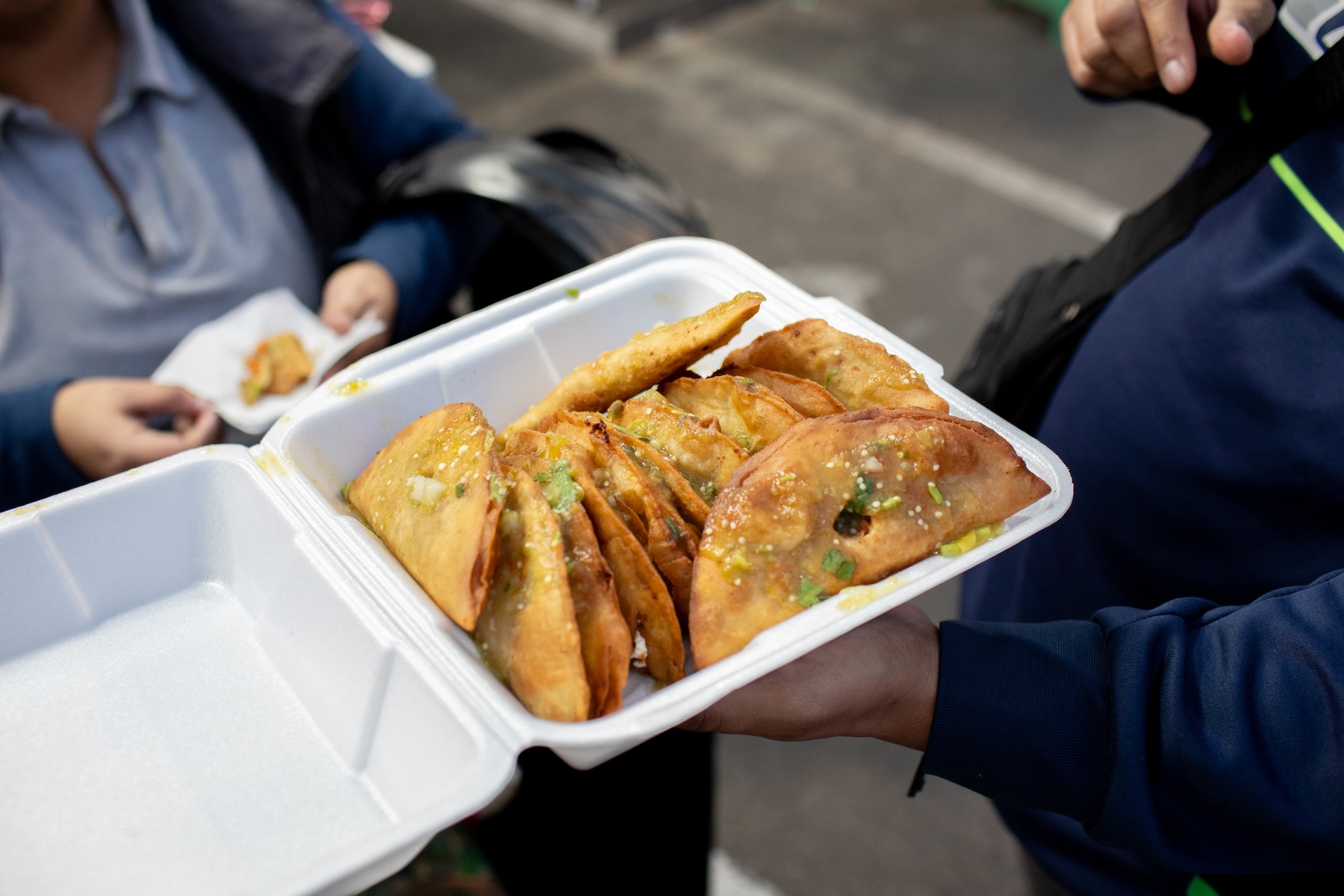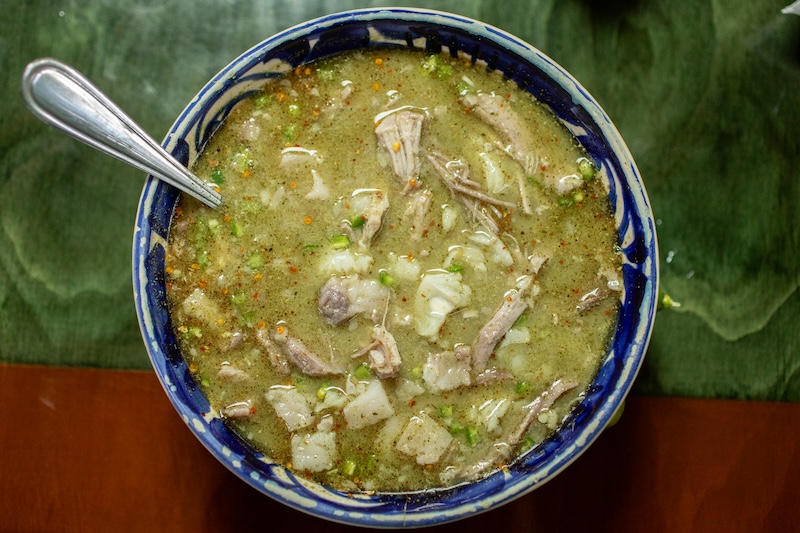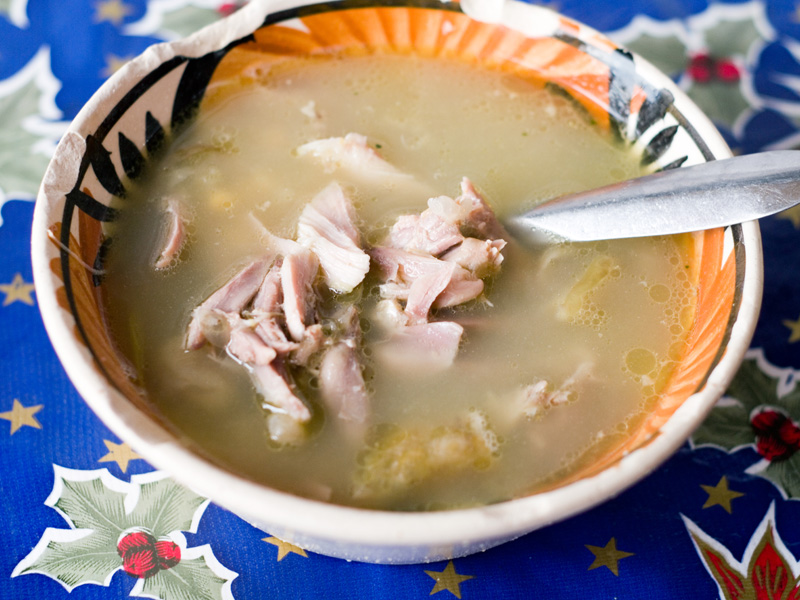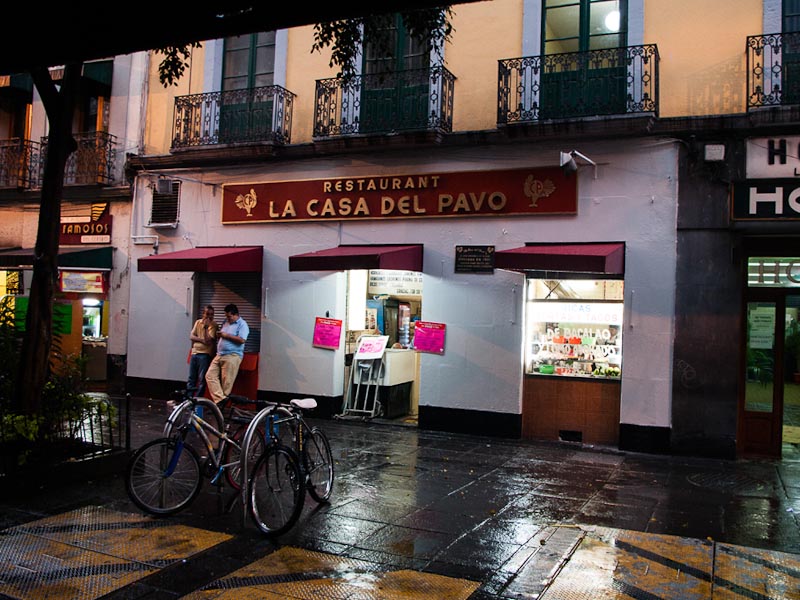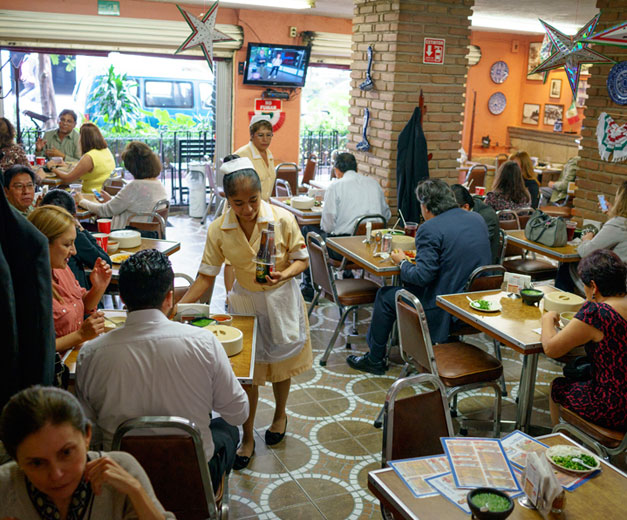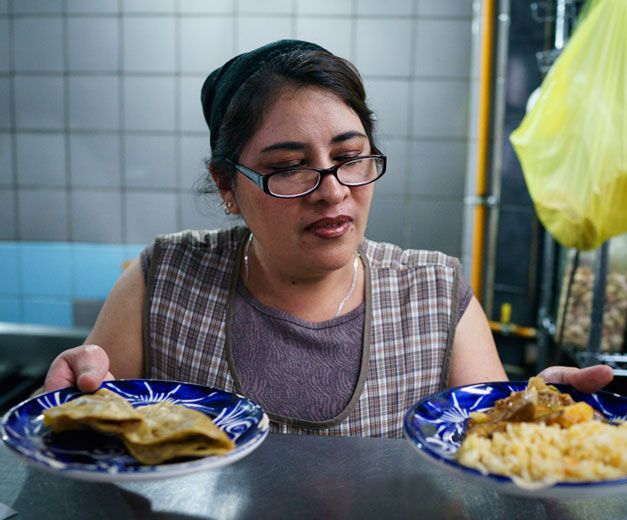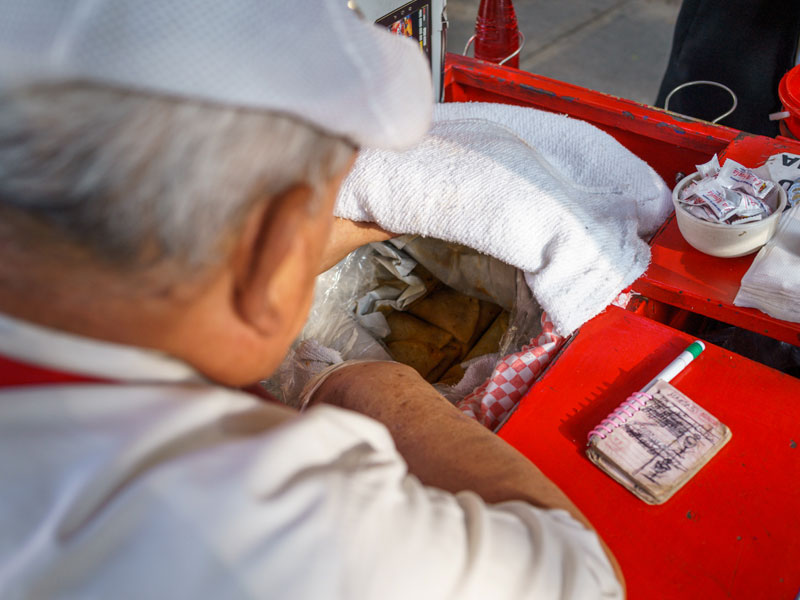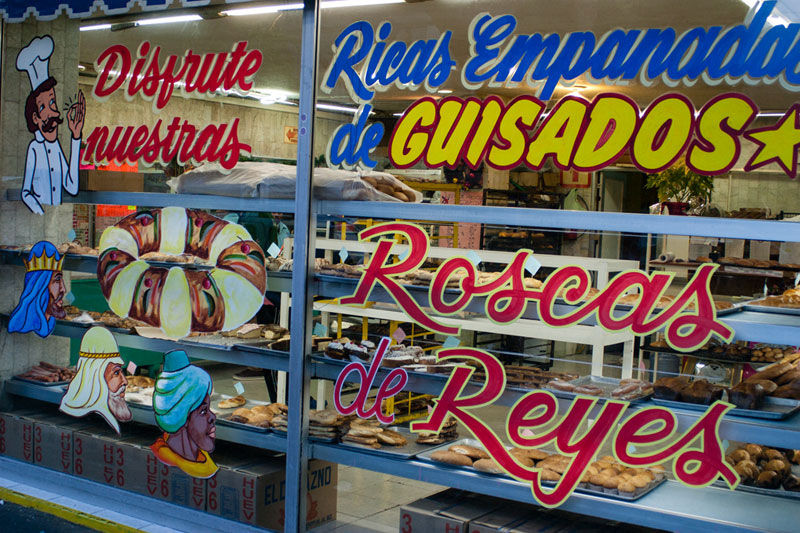We can't find the internet
Attempting to reconnect
Something went wrong!
Hang in there while we get back on track
Search results for "Ben Herrera"
Mexico City
Quekas San Cosme: Reinventing the Quesadilla
One of the staples of Mexican cuisine (and of bar menus everywhere), the quesadilla can be found on almost every street corner and in every neighborhood market in Mexico City. Those served at Mercado San Cosme in Colonia San Rafael, however, redefine the quesadilla. Indeed, while this neighborhood market is far from being the city’s largest or most famous, it’s worth visiting just for a chance to eat at Quekas, an eatery housed in the market that makes some of the best quesadillas we’ve had in the city.
Read moreMexico City
El Pozole de Moctezuma: Soup of the Gods
Pozole, like the tortilla, is one of those ancient dishes that seem to be embedded in Mexicans’ DNA, serving as a culinary link to the ancestral past. A type of soup or stew that was a ceremonial dish in pre-Hispanic Mexico, pozole has yet to be widely commercialized, offered mainly in pozolerías, small restaurants that specialize in serving up the dish and little else.
Read moreMexico City
Caldos de Gallina Luis: The Hen House
Caldos de Gallina Luis – which a friend had been raving about to us for months before we finally made it there – is essentially a street food stand that has been trussed up to look more like a sidewalk café. Just a short walk from the Insurgentes metro stop, the venue is located on a side street next to a parking lot and opposite a sex shop, the glowing neon of the shop’s sign casting its pink light over pedestrians walking by.
Read moreMexico City
La Casa del Pavo: Talk Turkey
Editor’s note: Alfonso Cuarón’s film “Roma,” set in Mexico City between 1970 and 1971, is expected to win big at the Oscars this weekend – it’s up for ten awards. To celebrate the movie’s success, we’re republishing our 2013 review of La Casa del Pavo, where the main character, Cleo, goes to have a sandwich with her co-worker on their day off and meet up with their boyfriends. Not only is this spot one of the few from the film that is still in business, it is almost completely unchanged. The bird that holds pride of place at the Thanksgiving table has just as important a role south of the border. Turkey has actually been a fundamental part of Mexican cooking for centuries: The Aztecs had domesticated the fowl before they had even laid eyes on a chicken.
Read moreMexico City
Beatricita: Taco Centenarian
In a town that runs on tacos, tacos de guisado may be the most ubiquitous version of the iconic dish in Mexico City. They can be found almost anywhere in the city, from specialty restaurants to markets, tianguis and street vendors selling them at stalls or even out of the trunk of a car. It may be an obvious point, but what distinguishes some tacos de guisado from others is how well prepared the guisados (home-style cooked meats or vegetables typically displayed and kept warm in earthenware dishes called cazuelas) are – and sometimes those coming out of the back of a car top ones from more “established” places. With so many places to choose from, how to determine who makes the best tacos de guisado in town? One contender we had long heard about is Beatricita, a brick-and-mortar taquería in the Zona Rosa that has quietly been using the same recipes to great acclaim for almost 110 years – certainly strong evidence that its guisados could be some of the best in the city.
Read moreMexico City
Bean Week: Mexico's Mealtime Mainstay
In Mesoamerica, beans have been a pillar of culinary traditions – not to mention civilizations – from time immemorial. Pre-Columbian peoples depended on legumes as their primary source of protein, but they were more than mere sustenance. Beans (along with corn) were some of the most important crops for sale at the local markets because they could be used as currency. Their value was based on the physical appearance of the product (color and size). The Aztecs included beans in the list of tributes that their vassal states had to pay. Bernardino de Sahagún, a Spanish friar, documented the use of beans in the Aztec empire, noting that the native people ate tamales mixed with beans. Storing and administering these crops was critical in order to be prepared for times of shortage.
Read moreMexico City
Tres Leches: The Magic Number
Pastel de tres leches is beloved throughout much of Latin America, and yet its origins remain a mystery. Some people claim that it was first baked in Nicaragua, others that the recipe was first printed on the label of a well-known brand of canned condensed milk in Mexico. Tres leches is usually a sponge cake soaked – as you might have guessed from the name – in a mixture of condensed, evaporated and regular milk, which might be flavored with vanilla, rum and cinnamon. The cake is baked and soaked in the milk mixture while it’s still warm and in the pan. It sits overnight so that the milk and flavorings thoroughly saturate every bite.
Read moreMexico City
Huaraches Rossy: Big Stuff
Visiting the Jamaica plant and flower market is one of our favorite activities in Mexico City; we love getting lost in its green alleys and never fail to emerge with at least one new plant and a beautiful bouquet of flowers. And of course, we’re always on the lookout for new places to eat. Our favorite barbacoa joint is in this market, but when we want a different experience we head to the huarache alley, where several stalls offer this tasty Mexican specialty.
Read moreOaxaca
El Pochote: Land to Table
Oaxaca has become one of our favorite food destinations in Mexico. A few weeks ago we visited the city again, but this time it wasn’t the moles or the decadent regional food that caught our attention, but an organic market where we had a delicious breakfast one morning. El Pochote (named after a thorny, flowering tree native to Central America) is an organization of local organic producers that was founded in November 2003 by local artist Francisco Toledo. Making an omelet at Mamá Lechuga, photo by Ben HerreraThe market offers all kinds of products, from vegetables and fruits to prepared meals and juices. The main objective of the market is to support those who grow or make healthy products of excellent quality, who interact with the natural environment in a way that respects local ecosystems and who maintain and increase the fertility of the soil and land.
Read moreOaxaca
Caldo de Piedra: Stone Hot Soup
In Oaxaca, a state where gastronomy is almost a religion, there are some extraordinary dishes that are prepared only for special occasions because of the complexity of preparation. Mole chichilo, for example, uses more than 30 ingredients, and its preparation can take up to 3 days. But there are spectacularly tasty (and complex) dishes that can be had anytime. One of these is caldo de piedra (stone soup) from the Tuxtepec region. On our last visit to Oaxaca City, we visited a restaurant a few miles outside of the center whose rendition of this soup blew our minds.
Read moreMexico City
El Rey de las Ahogadas: All Hail the King
We’ve written previously about flautas, one of our favorite street foods. Those crisp, finger-friendly “flutes” with their deeply savory, spiced chicken, pork, beef or potato filling are all about the gratifying crunch of the golden, deep-fried rolled tortilla (and the sour cream and grated cheese don’t hurt either). It’s hard to imagine how that winning combination can be improved upon, but at El Rey de las Ahogadas in Colonia Del Valle, we’ve found a delicious alternative. Although El Rey offers quesadillas, tacos and other Mexican delicias, as the big banner above the open storefront advertises, people come here mostly for the flautas ahogadas. These “drowned” flautas sit in a bowl filled with a soupy salsa verde so that they soften.
Read moreMexico City
Ask CB: What Are Aguas Frescas?
Dear Culinary Backstreets, I’ve heard about drinks in Mexico called “aguas frescas,” but what exactly are they? Visitors to Mexico are sure to encounter aguas frescas, a popular category of drinks that are ubiquitous at food stands and eateries around the country. These colorful beverages, whose name literally means “fresh waters,” come in a variety of different flavors depending on the main ingredient, but generally all are made by mixing a fruit juice with water and sugar.
Read moreMexico City
El Dux de Venecia: The Dukes of Bar Food
Visiting establishments with a lot of history always warms the cockles of our heart – even more so when that establishment is the oldest surviving cantina in the city. El Dux de Venecia didn’t start out as a cantina, but it became a drinking establishment in Azcapotzalco – a farming community that became part of Mexico City in the 1940s – during the Mexican revolution and has remained an important part of the neighborhood ever since. The story goes that an Italian traveler decided to open a grocery store at the end of the 19th century. He named it El Dux de Venecia (The Doges of Venice) because he was originally from that Italian city. He offered all kinds of imported products from Europe as well as local ones, including deli meats, bread and alcohol. Because some customers consumed these items in the shop, the owner installed chairs and tables for their comfort.
Read moreMexico City
Paletas and Raspados: Cooling Down in Mexico City
Editor’s note: It’s Beat the Heat Week at Culinary Backstreets, and in this week’s stories, we’re sharing some of our favorite spots to visit when the summer temperatures soar. Mexico City is blessed with great weather all year round. Summer is not very hot because it’s the rainy season, and at 2,200 meters above sea level, things cool down very fast as soon as the rain starts falling. However, we still get our hot days, especially in the spring, and even early afternoons in summertime can make us break out in a sweat. Two of the many delicious ways we have to cool down are paletas (popsicles) and raspados (shaved ice).
Read moreMexico City
Coox Hanal: Peninsular Gastronomy
The holiday season is one of the more subdued times of the year in Mexico City. Many people leave the city for vacation or to visit family and friends in other parts of the country. We, however, tend to stick around more often than not, traveling around the city and enjoying the relative peace. That’s how we happened upon Coox Hanal, a restaurant hidden inside a century-old building in the Centro Histórico that specializes in the cuisine of the Yucatán, the peninsula that juts out into the Gulf of Mexico and the Caribbean Sea like a hitchhiker’s thumb. The adventure began when we trudged up a few flights of stairs to the second-floor landing, where we found the restaurant’s entrance. It, along with the stairwell, was plastered with posters and artwork from the sun-kissed and beach-filled Yucatán.
Read moreMexico City
Birria El Güero: Landmark Soup
Colonia Santa Maria La Ribera, one of our favorite dining neighborhoods in Mexico City, is home to the historic kiosco morisco. Built in 1884, the Moorish open-air pavilion represented Mexico at the St. Louis World’s Fair in 1902 and has been in its current location since 1910. Just a few steps west of it sits a nondescript hole in the wall, which figures as prominently as the kiosk in our mental map of the neighborhood. Owner David García Maldonado offers just a few items on the menu, two of which are outstanding: pozole, a broth made from pork and maíz cacahuazintle, or hominy, and goat birria, a typical soup from the state of Jalisco.
Read moreMexico City
Máare: Hot Times in the City
The oldest suburb in Mexico City, Santa María la Ribera has seen better days, but it continues to surprise us with cultural and culinary discoveries. One of the most emblematic sites of this colonia is Alameda Poniente park, where, at the center, sits the beautiful Kiosco Morisco, a Porfirio Díaz-era pavilion that is often used as the backdrop for wedding and quinceañera photographs. Right in front of the park is Máare, a Yucatecan restaurant that has been one of our most delicious discoveries in Santa Maria la Ribera. In business for more than eight years, this restaurant is the brainchild of José Ramón and Gabriela Castilla. Although José Ramón has lived in Mexico City for 25 years, he’s extremely proud of his Yucatecan heritage.
Read moreMexico City
Mariscos El Paisa: Market Gourmet
Mexico City’s Mercado Jamaica, a jumble of produce vendors and flower sellers, is not a place you would expect to find a gourmet establishment in. But this is what makes this public market so appealing: Hidden away among the various vendors in this massive market are several outstanding food spots, ranging in size and scope from a nondescript green chorizo taquería to a fine-dining seafood spot. Mariscos El Paisa didn’t start out as a “gourmet” restaurant when it first opened back in 1958 – like many other market establishments, it was humble and unpretentious. But in recent years, the kitchen has upped its game, putting out elevated seafood dishes (although the restaurant still retains an unpretentious vibe).
Read moreMexico City
Día de los Muertos: Grateful for the Dead
Día de los Muertos (Day of the Dead), or at least some variation of it, has been an annual celebration in Mexico for over 3,000 years. During the Aztec period, it took the form of a festival in August dedicated to Mictecacihuatl, otherwise known as the Lady of the Dead. Today it is one of Mexico’s most colorful holidays, encompassing popular traditions both old and new. To the Aztecs, death was nothing to be feared; it was but a passage and a continuation to the next level of consciousness. Life was viewed as a state of dreaming and death was when someone was truly awakened from their slumber. The Aztecs’ monthlong festival was meant to honor those who had passed on and to entice their souls to visit once more.
Read moreMexico City
Las Mas Altas Montañas: Market Fresh Chorizo
As soon as you enter Mercado Jamaica, one of Mexico City’s largest markets, you will quickly see (and smell) its main trade: flowers. Down the long aisles, hundreds of sellers line up colorful flowers that come from Xochimilco and other states. Visiting the market truly engages all the senses. But, you may ask, how does this include taste? Well, Jamaica Market happens to be home to several outstanding food vendors, among them one of our favorite taco stands in all of Mexico City. Hidden away among the market’s produce vendors, this stand doesn’t have a sign, and you can easily miss it if you don’t know what you’re looking for. Once you find it, though, you’ll keep coming back for their superb green chorizo tacos.
Read moreMexico City
Chiles en Nogada: The Taste of Independence
Mexicans can mark their calendars by what they’re eating: moles for weddings, pan de muerto for Day of the Dead, lomo and codfish for Christmas and chiles en nogada for Independence Day. Every September 15 and 16 Mexicans gather together to celebrate their independence from Spanish rule. This movement started in the city of Dolores Hidalgo, in the state of Guanajuato, the night of September 15, 1810, when Father Miguel Hidalgo y Costilla gave el grito de Dolores (“the Cry of Dolores”) that ignited the War of Independence. This war lasted until 1821, when Agustín de Iturbide, who later became the first Mexican Emperor, signed the Treaty of Córdoba that granted Mexico its independence.
Read moreMexico City
Cactus Popsicle: Touring Mexico City’s Ice Cream Scene
In Mexican cuisine, sweets are for the most part simple treats that are enjoyed at the park, market or beach, such as caramelized fruits and vegetables, blocks of nuts or amaranth seeds held together with honey, or small rice paper cakes filled with honey. The common denominator of most of these sweets is their simplicity. When it comes to ice cream and other frozen delights, however, the country truly shines, with an astounding variety of cold treats to please sweet tooths of every persuasion. The range of frozen desserts found in Mexico City includes everything from raspados – ice shavings served in plastic bags or cups to which a flavor of choice is added – to Italian gelato served in some of the most sophisticated restaurants in town.
Read moreMexico City
Tortas La Texcocana: Size Isn't Everything
It is not hubris to say you have the best tortas (Mexican sandwich) in town when you have been serving them for more than 80 years. Take Tortas La Texcocana, which has been serving the delicious sandwiches in Mexico City since the early 1930s – their longevity suggests an unsurpassable skill for sandwich-making. The business was founded by León Sánchez, a Texcoco native, in downtown Mexico City. He started selling sardine tortas to newspaper workers on the street. In 1936, he established a small shop that sold various items, his famous tortas among them. Tortas La Texcocana is in the same venue where Sánchez set up his shop many decades ago.
Read moreMexico City
Taquería El Progreso: Tacos for All
Deep in the trenches of one of the oldest union strongholds in Mexico City, there’s a deeply democratic taquería that manages to bring together office workers, blue-collar workers, locals and tourists alike. When you walk by this place, chaos seems to reign. However, once you step into the current you realize there’s a system that keeps the flow of people, tacos, and drinks under control. Taquería El Progreso started serving beef head, suadero (a cut similar to brisket) and tripe tacos 23 years ago. Javier Ramos, an employee who has been working there since the beginning, told us that at first the taquería was about a third of its current size.
Read moreMexico City
Pulque: A Strange Brew's Revival
Milky, tart, viscous and slightly foamy. At first glance and sip, there’s little to explain why pulque – a mildly alcoholic drink made by fermenting the fresh sap of certain types of maguey, the same plant used for making mezcal – has remained a trusted companion to Mexican drinkers since Aztec times. Pulque, actually, has not only survived, but, after decades of losing ground to beer and soft drinks and their high-priced marketing campaigns, this workingman’s brew is making a comeback. New pulquerías are popping up in hip Mexico City neighborhoods and attracting a younger crowd while old pulquerías, which endured some lean times, are seeing an influx of new customers, who now sit side-by-side with older generations of loyal pulque drinkers.
Read moreMexico City
La Morenita: Fishy Business
Mexico City can be quite lacking when it comes to finding fresh, tasty seafood. At most markets in the city, in addition to the taco places and tlacoyo vendors, there is usually some kind of stand selling seafood, but the quality can be either very good or very bad. Buying from the right place is thus essential, and that’s why we were so happy to discover La Morenita, a standout seafood and oyster restaurant in Colonia Roma’s Mercado Medellín. Established more than three decades ago by Miguel Gardono, La Morenita has become a busy, reliable stop for shoppers.
Read moreMexico City
Tacos Árabes La Periquita: Pita Hut
(Editor's Note: In honor of the immigrants and refugees who have made their new home a better place for us all, this week we are running some of our favorite archived stories about those who have left a culinary mark on their adopted land.) Although we’re always hitting the pavement in search of the next good place to eat, sometimes places come to us. Such was the case with Tacos Árabes La Periquita, or “The Little Parrot,” an unassuming taquería in San Rafael that serves a relative rarity in Mexico City: “Arab tacos.”
Read moreMexico City
Carnitas El Azul: Mystery Meat
Mexico City is so vast that there are food places that can reach legendary status and still manage to remain unknown to most people. Take the case of Carnitas El Azul in Colonia Juárez. We had heard rumors about a place so good, Enrique Olvera – a Mexican chef who has also reached legendary status – unreservedly recommended it. However, when we asked around about it, nobody knew where it was or if it even existed. Only one friend, an expert eater, knew the hidden location of this mysterious jewel. “It’s really hard to find,” he said, promising to take us there. The day finally arrived. We met at the Insurgentes roundabout and walked towards the northwest exit.
Read moreMexico City
CB on the Road: Paradise Found on the Yucatán's Isla Holbox
Even in well-trod Mexico, little pockets of paradise can still be found. Located to the north of the Yucatán Peninsula in Mexico, where the Gulf of Mexico meets the Caribbean, little Isla Holbox is one of the most beautiful places we have visited in the country. It’s easy to lose track of time just meandering down dirt roads past brightly painted palapas (buildings with palm-leaf roofs), sunning yourself on a tranquil beach, watching spectacular sunsets and eating delicious seafood. Getting to the island isn’t easy, however. There are buses from Mérida, Cancún and Playa del Carmen to Chiquilá, and the trip can take up to four hours on roads that are not always the smoothest. From there, ferries cross over the Yalahau lagoon to the final destination.
Read moreMexico City
Los Barriles: Taco Saturday
For the last few months we’ve been obsessed with finding the best tacos de guisado in Mexico City. This is not an easy task because these types of tacos are abundant in a city where people are always on the lookout for inexpensive and fast eats. We have tried some amazing tacos de guisado throughout the years, but we keep finding new and delicious places in a city that never fails to impress us. A few months ago we started going to the Saturday Sullivan market for just one reason: eating breakfast at Los Barriles, a booth that sells between eight and 10 different types of tacos de guisado – usually ready-made stews served atop a tortilla – at a time.
Read moreMexico City
Fonda El Refugio: The Comeback Kid
Fonda El Refugio is a name that you will likely come across when looking at guides to Mexico City. The small restaurant in Zona Rosa, a popular tourist destination, has been serving authentic Mexican food for more than 57 years. Politicians, artists, writers and all kinds of celebrities have dined here over all those decades. Renowned writer Octavio Paz chose this restaurant’s food for his banquet with the Mexican president after receiving the Nobel Prize in literature in 1990. However, in recent years the quality of the food took a turn for the worse, and this iconic restaurant’s reputation took a major hit.
Read moreMexico City
Tacos de Canasta La Abuela: Inside Grandma’s Basket
Just a block away from Mexico City’s financial district one unlikely food star sets up shop every morning. From Monday to Saturday, at La Abuela, 72-year-old Arnulfo Serafin Hernandéz feeds hungry office workers, commuters, neighbors, school kids, government officials and tourists from all over the world with one of the simplest Mexican dishes: tacos de canasta. He fries a corn tortilla a little in lard or oil, fills it with one of the prepared ingredients, folds it in half and places it carefully inside a canasta, or basket. He wraps the tacos in cloth and covers them with plastic to keep them warm. This also makes them moist and soft when serving, two of the most important characteristics of a good taco de canasta.
Read moreMexico City
CB on the Road: Eating Mérida
Mexico’s Yucatán Peninsula was home to some of the most important Maya cities during pre-Hispanic times. One can still get a glimpse the glory of those cities in ruins such as at Chichen Itza, considered one of the seven wonders of the modern world. On the ruins of a smaller Mayan city, T’ho, the Spanish conquistadors founded Mérida in 1542; since then, the city has been the economic, cultural and gastronomic center of the Yucatán Peninsula. We visited the city recently and fell in love immediately. Thanks to its proximity to the harbor of Puerto Progreso and the importance of the henequen industry – which turned the fibers of a native agave plant into rope – Merida’s culture, economy and architecture grew dazzlingly from the 19th through the early 20th century.
Read moreMexico City
Baby Fish: Savior of the Landlocked
In landlocked Mexico City – the nearest coast is 250 miles away – you might think that it would be difficult to find fresh seafood. However, ever since Aztec times, the ocean’s bounty has been brought to the valley daily. Back then, the Aztec emperors got their goods using a system of relay runners that covered those hundreds of miles from sea to city per day. Things require less footwork today: technology and Mexico’s highway system allow daily deliveries of fresh seafood to the capital from the Pacific and Gulf of Mexico coasts. That said, feeding the Mexican capital’s fish craving still requires some hustle.
Read moreMexico City
Barbacoa Renatos: Flavor Underground
We’d heard from a colleague that Renatos had the best barbacoa game in town, and we finally got the chance to confirm this claim for ourselves a couple of weeks ago. This family joint in Mexico City’s Azcapotzalco neighborhood has been in business for 55 years. Its owner, Renato Álvarez, gave us a little history lesson about his family and their barbacoa business. The barbacoa recipe prepared in Renatos is from the state of Hidalgo, famous for mutton slow-cooked in a pit dug into the ground.
Read moreMexico City
Café La Habana: Literary Grounds
For more than six decades now Café La Habana has served great coffee from the state of Veracruz and also sells the beans by the kilo. As in many Mexican restaurants, it offers café lechero, which is one or two shots (depending on the customer’s preference) of very strong espresso in a large glass that is then filled up with hot milk. One of our favorite drinks here, however, was the café bombón (roughly translated as “marshmallow coffee”), a cortado double espresso shot with ground coffee sprinkled on top.
Read moreMexico City
Aguamiel: Dreams of Oaxaca
Deservedly famous for its rich food traditions, the state of Oaxaca is one of our favorite culinary destinations in Mexico. But with Oaxaca City lying nearly 300 miles southeast of Mexico City, we’re always on the lookout for places to satisfy our appetite for Oaxacan cuisine in the D.F. Specializing in tlayudas, one of Oaxaca’s most typical foods, the recently opened Aguamiel is a very welcome addition to the local dining scene.
Read moreMexico City
CB on the Road: Striking Culinary Gold in Zacatecas
Although, thanks to its once flourishing silver and gold mines, the north-central Mexican state of Zacatecas was an economic powerhouse during the colonial period and the early years of the Mexican republic, its cuisine is not as well known in Mexico City as that of states such as Oaxaca and Michoacán. But when we headed this past New Year’s to the state’s eponymous capital city, we were blown away by its food, as well as its history and beautiful colonial architecture. Zacatecas played a significant role in Mexico’s economy during the colonial period: When the Spanish conquistadors learned about the region’s rich mineral deposits in the mid-16th century, they started mining operations immediately. In 1585, the city that had grown from the mining settlement was recognized by the Spanish crown and called the “Muy Noble y Leal Ciudad de Nuestra Señora de Zacatecas.”
Read moreMexico City
Rosca de Reyes: A Tradition Fit for Kings
In Mexico, Epiphany (or Día de Reyes, in commemoration of the Three Magi’s visit to the baby Jesus), celebrated on January 6, offers an opportunity to extend the Christmas season. Mexican kids go to bed early on January 5, expecting to find gifts next to the Nativity scene the following morning. The traditional way to celebrate this holiday is by eating rosca de reyes ("kings’ cake"), an anise-scented, ring-shaped cake or sweet bread decorated with slices of candied fruit.
Read moreMexico City
Birria Santa Bárbara: Hangover Helper
For a case of the morning-afters, Mexicans believe that the best cure is a bowl of hot and spicy broth. On Sundays you’ll find the bleary-eyed, hard-partying denizens of Mexico City seeking out restorative traditional soups like the tripe-based menudo, also known as pancita; caldo tlalpeño, made with chicken; and birria. Birria, which means “mess,” is a typical rustic dish from the western state of Jalisco, where it’s made with goat. In Mexico City, however, birria is most commonly made with beef, mutton or pork. And many birria lovers in this town swear by Birria Santa Bárbara in Colonia Verónica Anzures.
Read more